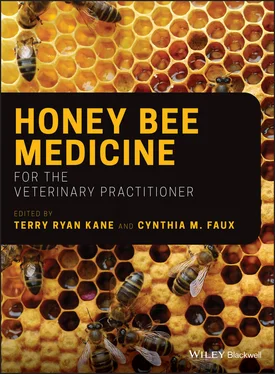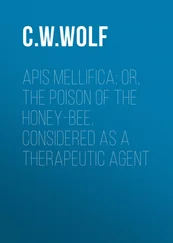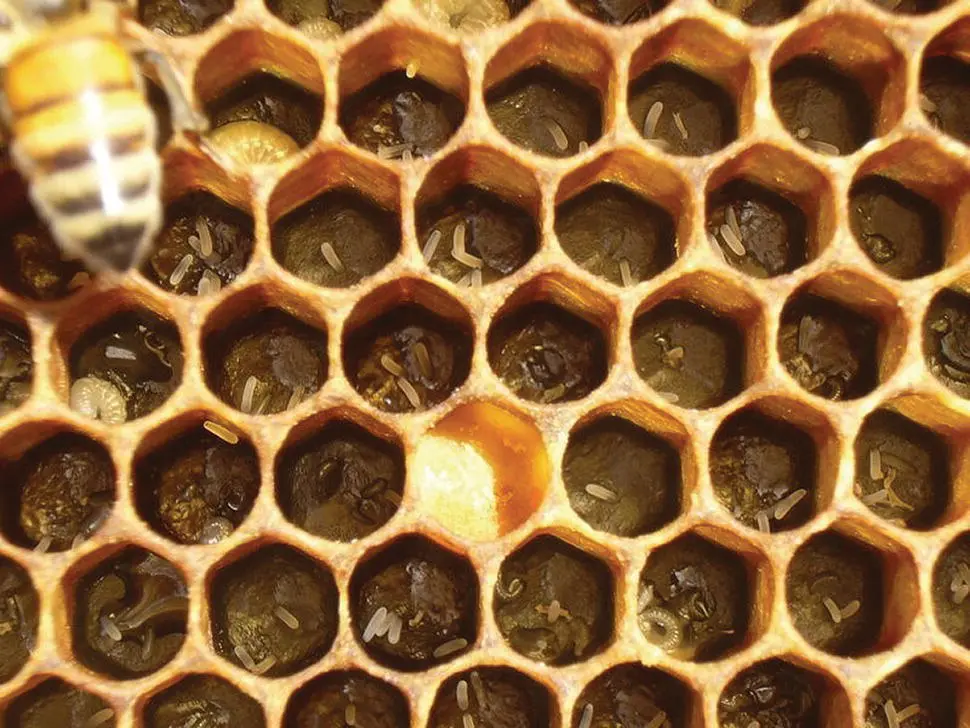
Figure 5.25 Typical eggs from laying workers. Unlike those laid by a queen (singly and upright in the center of each cell), laying workers often place several eggs in a cell, not centered, and sometimes on the cell wall. Compare this egg pattern to that in Figure 5.7.
Practical application: Signs of laying workers normally don' t appear until around three weeks after the loss of the queen.
A laying worker hive can survive for quite some time, but tends to become “pissy” and full of undersized drones.
Practical application: Once a colony goes “laying worker,” it is difficult to requeen. Although there are any number of “folk remedies” for requeening a laying worker colony, it is generally easiest to temporarily combine it with a queenright hive, wait a few days for that queen's pheromones to again suppress the ovaries of the laying workers, and then to split the combined hive, giving the queenless portion frames of brood and an introduced queen or a queen cell.
Beginning beekeepers often wonder whether their colony has “gone queenless,” or if their queen if “failing.” The vet should be able to address these questions. The vet's first assessment would be to determine whether the colony is:
“Queenright” – containing a functioning, laying queen,
“Queenless” – with perhaps a queen in the works, or
“Hopelessly queenless” – meaning that the colony has not only lost its queen but has passed the window of opportunity to replace her. A colony at this stage often exhibits the signs of having gone “laying worker.”
Signs of Queenrightness, Failing Queens, and Queenlessness
It is generally much easier to find signs of a queen than to spot the queen herself, and in most cases there is no need to actually see the queen. If there are eggs and larvae present, that usually indicates that the colony is queenright, especially if the egg pattern is as below ( Figure 5.26).
Queens do “age,” and in the process may exhibit poor brood patterns, suggesting that they be replaced. In general, few queens are good for more than a year and a half of egg‐laying, by which time their spermatheca simply runs out of viable sperm. At that point some eggs laid in worker cells will develop into drones ( Figure 5.27).
The workers apparently cue on unfertilized eggs as a signal that the queen is failing and will usually supersede a queen before this becomes noticeable, but if they wait too long, they may not have any female larvae from which to raise a replacement queen.
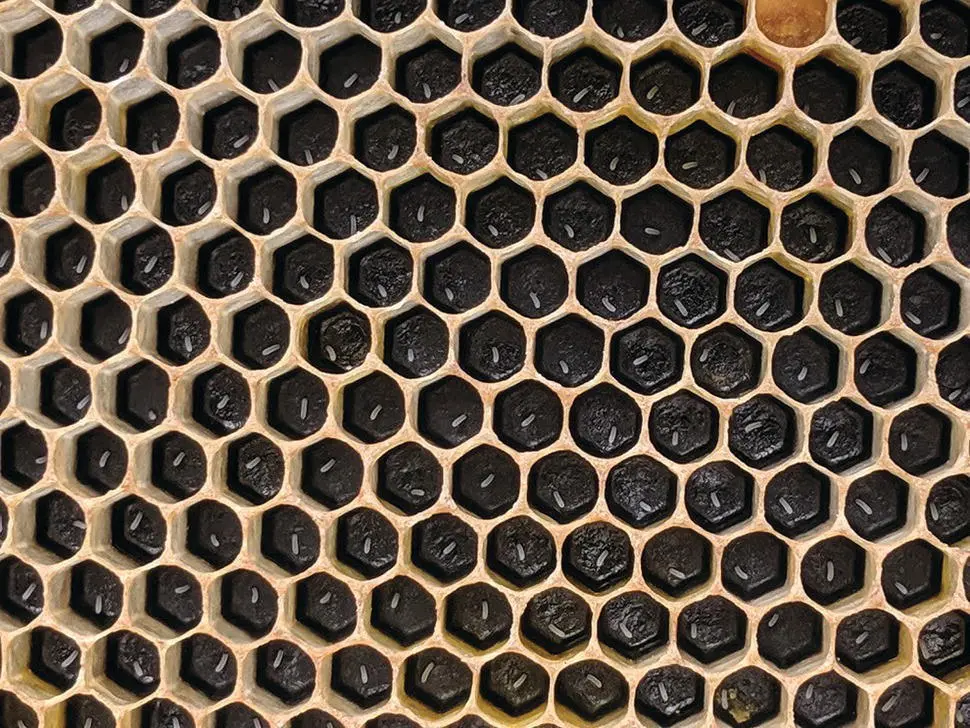
Figure 5.26 A nice egg‐laying pattern by a queen – each egg centered in its cell, with no misses. The eggs are glued upright and typically slightly tilted (often the eggs are all tilted in the same direction). A pattern such as this indicates a high‐quality queen.

Figure 5.27 Raised drone cells scattered among worker cells, as opposed to groups of drone cells at the edge of the comb, indicate that a queen has gone “drone layer” – meaning that she is running out of stored sperm with which to fertilize worker eggs.
A colony that loses its queen while there are eggs and young larvae present will generally (weather and predators permitting) successfully requeen itself.
Field signs for a queenless colony:
No eggs or young larvae, although there may be other causes for this.
The sound of a “queenless roar” when smoke is applied across the combs.
The workers are agitated, exhibit jittery wings, and become defensive.
The presence of emergency cells.
Eventually, a “hopelessly queenless” colony will exhibit signs of “laying workers.”
The lack of eggs and young larvae is not a conclusive sign of queenlessness, since the colony may have simply ceased broodrearing due to dearth, or may have a new queen in progress (typically referred to as a “virgin” until she starts laying eggs). The other signs in the above list are more conclusive.
Signs of Being in the Process of Self Requeening
A colony in the process will have either queen cells of some stage present, or a virgin queen. A virgin is difficult for the untrained eye to spot.
Practical application: if a colony has recently lost its queen, emergency queen cells should be present. One way to test for queenlessness is to insert a frame of eggs and young larvae from another hive; if the colony is indeed queenless, it will start the construction of emergency cells on that frame by the next day.
Practical application: A colony in the process of requeening itself is generally calm, not jittery, does not “roar” in response to smoke, and prepares the cells in the center of the broodnest for the new queen to lay in, by keeping them polished and free of food stores. If the bees are storing nectar and pollen in the center combs, suspect queenlessness.
Signs of Being Hopelessly Queenless
Practical application: A colony that has been truly queenless for more than five days, and which does not have emergency cells in progress, will be unable to requeen itself, and is termed “hopelessly queenless.”
The typical signs of a hopelessly queenless colony are:
Lack of cluster formation,
The “queenless roar” when smoked,
Jitteriness of the workers' wings,
Defensive behavior by the workers,
Frames containing scattered or only drone brood ( Figure 5.28),
Multiple eggs in the cells from laying workers ( Figure 5.25).
How to Tell a Drone‐Layer from a Laying Worker Colony
Since in either case there will be scattered drone cells, many beekeepers have trouble telling the two conditions apart ( Figure 5.29).
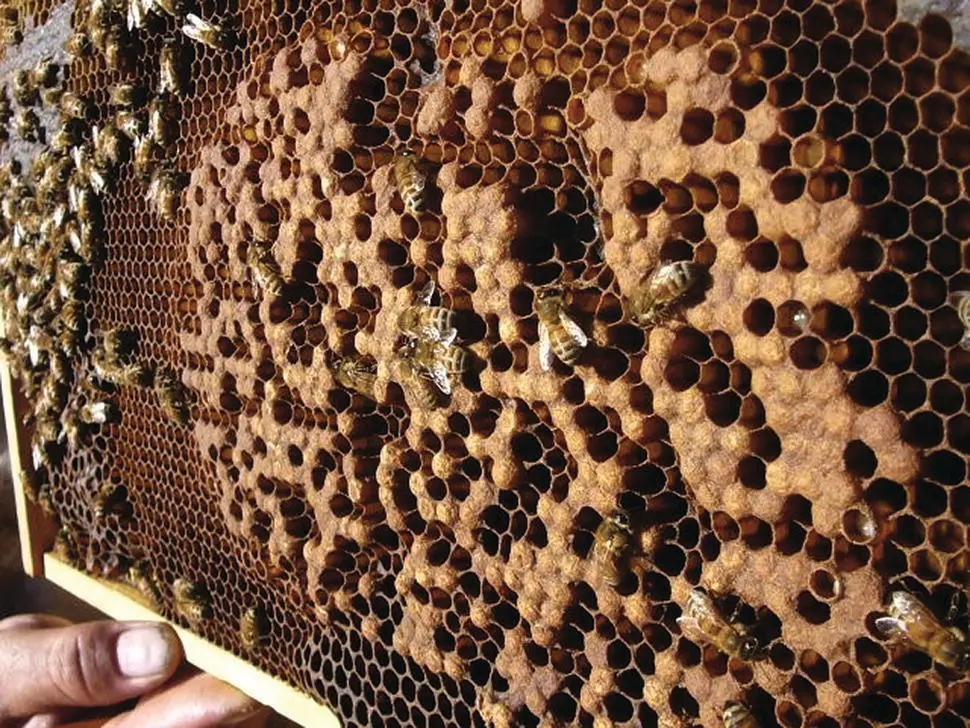
Figure 5.28 Drone cells are normally built in discrete patches, rather than scattered on the combs as above. If you observe scattered drone cells, look for multiple eggs within the cells, which would indicate that the colony lost its queen, and that some workers have activated their ovaries to become “laying workers.” A laying worker colony is doomed to death unless it is requeened by the beekeeper, which may be difficult.

Figure 5.29 A brood frame with scattered drone cells. In this case, there were only single eggs in the cells, indicating that it was a case in which the queen had gone “drone layer” (unable to fertilize worker eggs). This diagnosis was confirmed by noticing the presence of a queen.
Practical application: A drone‐laying queen and a colony with laying workers both exhibit scattered drone cells. But only in the case of laying workers are there are multiple eggs scattered in the cells.
Читать дальше
